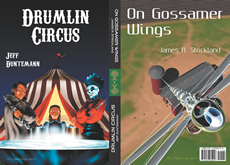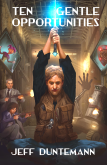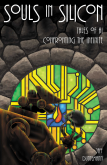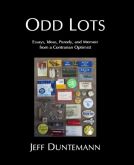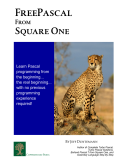- I’ve just added a book catalog page to my primary WordPress instance of Contra. There’s a link on the title bar at the top. If you’re using LiveJournal, here’s the direct catalog link. From my WordPress instance you can also go direct to an individual title within the catalog by clicking on one of the cover thumbnails in the right sidebar. It’s a little barebones for now, but it’ll do until I finish getting the Copperwood Press site rehabbed.
- This sounds worse than it probably is: B&N has restricted sideloaded content to only 1 GB of the Nook Color’s internal memory. The NC has become very popular as a somewhat broader device than an ebook reader, and I’m sure B&N is worried that people will fill the little slab up with so much of their own stuff that there’s no room to buy more from B&N. The key is the MicroSD slot, which (for the time being) can hold up to 32GB. If sideloaded content stored on the MicroSD card is completely accessible to the Nook’s machinery, it’s really not a terrible problem. (I don’t have an NC so I don’t know for sure.)
- B&N’s certainly been busy: There’s a new, inexpensive, smaller, lighter e-ink Nook in the pipe called Nook Simple Touch. 6-inch display and two months on a charge (sheesh!) will appeal hugely to commuters who just want to read books and not do seventeen things at once. $139; mid-June arrival.
- Then again, if you want a cheap Nook ($99) and don’t mind the orginal model, go to eBay.
- Here’s an expert’s braindump on ebook creation/formatting, which clearly highlights the appalling nature of ebook formats and ebook creation tools. Mobipocket in particular comes in for some (well-deserved) hard whacks with the baton. None of this crap should be necessary. An epub file is basically a collection of HTML documents with an external TOC, all wrapped up in a ZIP archive. Why is this so hard to do? (My thought: Immature rendering engines, like Web browsers in 1994. We are compensating for bad software.)
- This is the high road toward SSTO, and I hope to hell they can pull it off. The trick isn’t so much getting to orbit as getting back intact. We’ll see.
- From the Words-I-Didn’t-Know-Until-March-But-Forgot-Until-Yesterday Department: oneiric; meaning of or pertaining to dreams. Also the adjective in the next Ubuntu animal version code: Oneiric Ocelot, due this November. Not new news, but I forgot to mention it in March. Dreams, sure. But having read some of the fights that the discussion of Ubuntu Natty’s Unity desktop has triggered since then, I also picture an ocelot that lost one ear in a bar brawl.
- Bichons are notoriously hard to housebreak. Carbreak too, evidently.
- From the Painfully Obvious Research Department: A study (PDF) suggesting that when we see people breaking the rules, we assume that they’re powerful. Duh. (One wonders if a lifetime of watching powerful people be abject shitheads could have anything to do with it.)
- And a much more interesting study on the role that some airborne bacteria play in acting as seeds for precipitation. Get a look at that hailstone! (Duck!)
- Amen, brother. (Thanks to John Ridley for the link.)
dogs
Odd Lots
Tripwander: The Board Into Summer
We got back here to Colorado from Chicago just in time for the first snows. And while it snows like hell outside my window, I sit here in an interior fog, recuperating from a typical post-Chicago-trip headcold. I’m starting to climb out of it, but if you haven’t heard from me lately that’s mostly why.
The trip itself was short as such trips go, and was mostly concerned with getting Carol’s mom moved back home from the nursing facility where she’d been for some time. We also spent four days babysitting our nieces Katie and Julie while their parents took a much-needed break from parenting to attend the Ohio Valley Filk Fest in Columbus.
Tending small children is aerobic, to say the least. We ran around the back yard with them and the dogs, took them to several parks and playgrounds, and (finally) got a kite into the air in the big field behind their house. The kite was a nondescript 20″ ripstop Nylon diamond item from Wal-Mart, and it flew beautifully without any tail at all, thanks to a relatively light and steady wind. Katie (who is not quite four) flew it carefully and well, though whether she listened to my uncle-ish lectures on staying away from the power lines is unclear.

Carol and the girls blew soap bubbles and chased them, assisted by Dash. QBit watched dourly from the sidelines after he touched a biggish bubble with his nose and popped it all over his face. We retrieved any number of things (including Julie’s Hello Kitty boots) from The Window Well Where Balls Go To Die. Kick a ball around the yard long enough and it will end up there, though how the boots got in remains a mystery:
“Julie, did you drop your boots in the window well?”
“NO!”
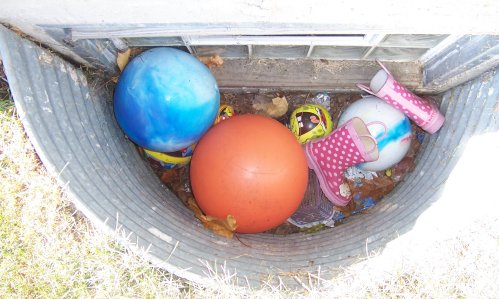
Well. I guess that’s that.
Of all the Pack, Dash clearly had the most fun. We deliberately had the neighbor girl come by regularly to play with Dash and his littermates when we first had them (and their mother) so that they would know what kids are and enjoy their company. And wherever there were kids, that was where Dash wanted to be. We watched him watching through the slats in the back fence while a group of local gradeschoolers played touch football in the field. His tail was wagging so hard I thought his butt would fall off. A few minutes later, I heard Dash’s distinctive yaps from a distance, and realized that he was out in the field with the kids, having somehow finessed the fence. When I went out the gate to fetch him I saw how he did it: There was a loose slat that wasn’t fastened to the bottom horizontal board, and he had just shoved it aside and pushed through the gap.
Fixing the fence was easy enough. The nails were still in the board, and I whacked them back into place with a handy half of a brick. We then watched Dash go back and forth along the fence for the rest of the afternoon, stopping at each slat and nudging it sidewise with his nose, clearly searching for The Board Into Summer.
We watched a lot of what passes for kid TV these days, including Phineas and Ferb (brilliant) Dora the Explorer (craftsmanlike) Wonder Pets (eh) and Fish Hooks (ghastly.) The cartoons provided a clue to an otherwise puzzling occurrance: We ordered in supper one evening from Mr. Beef and Pizza, including a styro container of chicken noodle soup. Julie grabbed the soup container and handed it to Gretchen, exclaiming loudly: “Arbor Day! Arbor Day!”
Arbor Day? I was puzzled until Katie followed up with “Por favor!” Ahh. Abrade! Open it! This was one of a number of Spanish words used in Dora the Explorer, which may be the girls’ current favorite cartoon. (Gretchen made Dora and Boots costumes for the girls for Halloween, though Julie refused to wear her Boots tail.)
On the last day we babysat, I came down a little oddly on my left leg running around on Gretchen’s uneven hillside, and, once I stopped writhing in pain, had to go to urgent care for an X-ray. Nothing was broken, but my knee swelled up something wonderful, and I was on a crutch for two days and visibly limping for the rest of the trip. Anaprox helped.
So we’re back, and I can now confront the huge wobbling pile of things I need to catch up on, making sure that all of the detonators go off. If one misses, well, the rest of the block will be toast.
Odd Lots
- I meant to post this back in May but the item went into a notefile while I was traveling and got misplaced: Larry O’Brien did a very nice detailed comparative review of my Assembly Language Step By Step, Third Edition and Randy Hyde’s Art of Assembly Language, Second Edition over at SDTimes. Larry understands better than most people that there are multiple ways to approach learning a topic, and that both books have value and don’t completely overlap one another.
- Another tardy item from that same missing notefile: Scientific American must be desperate for subscribers, as it had the courage to challenge the biggest sacred cow in medical science: the Fat Bad, Carbs Good nonsense that has blown us up like carnival ballooms since it was declared health dogma in the early 1970s.
- Part of the problem: Most medical studies are utter crap, and here’s why.
- And here’s an excellent example. Sadness makes me neither creative nor energetic. Furthermore, all the most creative people I know are borderline manic. Insane, maybe. Sad? Not in the least.
- In 1970, I built a vertex-first projection model of the 600-cell regular polytope in four space using D-stix. My senior-year math teacher hung the model from the steam pipes and I never saw it again, but here’s a photo of one made out of ordinary drinking straws. (Scroll down.)
- What is the frequency of a dog shaking water off its fur? The answer: greater than or equal to 4 Hz.
- Slate asked “Is the movie that almost killed Disney animation really that bad?” My answer: Yes. It’s the Seventies car in Disney’s otherwise reasonable animation garage, full of uninteresting things indifferently drawn, with the possible exception of the weird half-dog, half-leprechaun whatchamacallit Gurgi. The Horned King is the least menacing of all Disney cartoon villains, and certainly can’t hold a candle to Maleficent, Hades, or even Gaston. The Chronicales of Prydain is a decent kid-series, and deserves a remake.
A Big Lake in Autumn
I’ve been a little out of it the past few days, in the wake of an inadvertent encounter with Chinese Five Spice Seasoning, with which I’ve tangled before. Which of the five is the culprit remains a mystery, save that it’s unlikely to be either cinnamon (Chinese or otherwise) or cloves. No matter. I’m a caveman, not a gourmet, and spices regularly cause me various kinds of grief. (This time it was a bad migraine.) All better now. Hey, is that a giant beaver over there? Where’s my club? I’m hungry.
Anyway. We took a quick trip to Lake McConaughy last weekend, to find a lake just a few feet from full. All that beautiful lake bottom is now underwater, as it should be, but for almost ten years the lake was as much as fifty feet down due to drought in the watershed. I didn’t get photos of the crib when the water was at its lowest, but the two photos below (taken last weekend and about thirteen months earlier) will give you a sense for the magnitude of the change. In one year, the water rose over thirty feet, and once the winter rains begin methinks the spillways will see their first use in quite awhile.


We’ve had a slightly cool autumn, but Saturday took a foray back up into the mid-80s. Carol broke out her bikini and we got a little more than knee-deep in the 70-degree water before deciding that the season was indeed a little past its peak for swimming. So we ran the Pack along the beach, pausing now and then to fish burrs out of their paws and get photos of the fall foliage.

 While driving a Nebraska county track to the south shore, Carol noticed something odd in the dry cornfields to either side: The corn had been harvested from the top halves of the stalks but not the bottom halves. This seemed consistent (we stopped to look) and had a machine-like precision about it, suggesting that corn is harvested at various times depending on how dry the cobs need to be. We passed an evidently abandoned microwave tower, which provided a natural cover photo for a short novel concept I’ve been saving for a NaNoWriMo November when I don’t have to travel. It certainly won’t be this year.
While driving a Nebraska county track to the south shore, Carol noticed something odd in the dry cornfields to either side: The corn had been harvested from the top halves of the stalks but not the bottom halves. This seemed consistent (we stopped to look) and had a machine-like precision about it, suggesting that corn is harvested at various times depending on how dry the cobs need to be. We passed an evidently abandoned microwave tower, which provided a natural cover photo for a short novel concept I’ve been saving for a NaNoWriMo November when I don’t have to travel. It certainly won’t be this year.
We’re shopping for a new vehicle to replace Carol’s increasingly cranky 1995 Plymouth Voyager. The Ford Flex fascinates me, as it seems designed to maximize interior space, which is always handy when you’re transporting dogs in bulk. It’s AWD (which we need given where we live) and it can park itself. Precisely how (and how well) it pulls that trick I’m not sure, but given that flying cars will not be an option in my lifetime, I think I’ll take that and be glad of it.
Dash and the Fruit Bowl Bomb Habit

All dogs have quirks, and Dash brought a new one into the house with him: When he’s done eating, he picks up his bowl and carries it around. He shows it to us, and if we don’t take it and re-fill it, he drops it from mouth height. When he was three months old (see photo above) he was closer to the floor, and the bowls sometimes survived. Now that his mouth is at adult bichon height, the bowls usually buy it.
In the photo above, Carol had just fed him, and he had bumbled into my office, standing in front of me with his bowl in his mouth, as if to say, “Please, sir, can I have some more?”
We feed the Pack out of a motley collection of small midlate 1950s fruit bowls, manufactured in an era when people ate less, particularly of the sort of fruit you got out of small cans in the 1950s. Such bowls are still made if not widely used, and we bought a couple of Corelle fruit bowls in our Shadow Iris pattern specifically for Pack meals. Supposedly they don’t break if dropped from modest heights. Dash hadn’t heard that, and when he dropped one, it exploded into dagger-like shards all over the kitchen. So the Corelle fruit bowls now await an era when we again embrace canned fruit cocktail (in heavy syrup.) They may wait awhile.
After we were married 34 years ago, Carol’s mom gave us a (mostly) complete set of Joni’s Dixie Dogwood tableware, and we used it for years as our everyday settings. A lot of it is gone now, having fallen from slippery hands at the sink or over the edge of the table, but because we rarely used the fruit bowls, we still had them until recently. That is, we still had them until Dash started dropping them.
He dropped another one yesterday, RIP (Rest In Pieces.)
The only bowls that are safe to give him are genuine Melmac, in our case Mallo-Ware, from Chicago’s now-extinct Mallory Plastics. Again, they came from Carol’s mom, and Carol used them when she was a kid. There are only two of the venerable #52 fruit bowls left, and both are usually in the dishwasher when another Pack meal time rolls around. I think there used to be more, but I don’t know where they went. Like all Melmac tableware they’re essentially indestructable, so they certainly didn’t break. I think I drilled and tapped one for a telescope attachment in the 80s. About the rest, clueless.
Even when the two Mallo-Ware bowls are clean, the problem is that we have four dogs, and after Dash scours out his own bowl, he will go hunting for other bowls to scour. The last one he finds gets carried around, and if it’s a Dixie Dogwood bowl, it’s soon off to rejoin Joni in Crockery Heaven.
So I slid over to eBay yesterday in search of more Melmac fruit bowls, to find that Mallo-Ware has become collectible. Used #52 fruit bowls now go for three bucks each…and up. I searched and grumbled until I found a pack of ten beat-to-hell pastel bowls for $25. That will certainly do the job, but…collectible Melmac? I hear Alf giggling somewhere.
I guess “collectible” is relative, and cyclical. As best I can tell, Melmac tableware was invented to prove to my Aunt Josephine that depression glass wasn’t so bad after all. Alas, Aunt Josephine didn’t get the message. She’d gathered an impressive set of iridescent orange depression glass while a teenager and used it well into the Fifties, but when Melmac came along, her depression glass was relegated to the kids table (and nobody got chewed out if it broke) with the adults dining on indestructable pastel plastic. To my aunt, depression glass was an emblem of poverty, whereas Melmac was totally Space-Age. Eventually the glass all went into the trash, which I suspect my cousins are now regretting.
There’s no real point to this essay other than a reminder that dogs are unpredictable. Mr. Byte used to chew up computer books, but only computer books. Chewy would dance on his toes for…peas. Jack will not eat raw meat, and will pick out the rice or the vegetables and leave the meat for Dash. QBit steals Carol’s ponytail Scruncis and hides them under the pillow in his kennel. I’m not sure these are mutant instincts, but they’re certainly not anything we taught them, and remain the best evidence I could cite that Behaviorism is really quite sincerely dead!
Daywander
We’re at a dog show in rural Greeley, Colorado, a little north of Denver–and right smack dab next to a huge cattle feedlot. Now, I’m a caveman and a realist–manure is the price we pay for beef–but that stuff sure do stack up and make its presence known. We kennelled QBit and Aero to simplify show logistics, but it’s funny not having Aero with us at a show. He’s a champ now, and the spotlight has shifted to Dash, who at 15 months already has 11 points (of the required 15) and one major win (of the required 2) toward his own championship. Aero was always a shy dog, and fearful at the outset. This cost him points early on, but Dash has never had any such problems, and it’s (remotely) possible that he could score a big enough win this weekend to make him a champion while still technically a puppy. (He won’t reach his majority until 18 months.) Master groomer Jimi Henton will be helping Carol make him and Jack look their best, and we have high hopes.
I just finished a dozen Lucerne eggs and I’m still alive to write about it, so the big contaminated egg thing may not be as horrible as some are making it out to be. But half a billion eggs, sheesh–and that from one company. Am I going to give up eggs? Hardly. My sole gripe is that Lucerne’s are the only eggs I can find locally in Medium, and I’ve titrated myself to a pair of Medium eggs scrambled for breakfast as what best carries me until lunchtime without any energy lapses. So I may have to fall back to a single Extra Large until I can scare up a different brand of Medium eggs. And while eggs are on the table here, does anybody see size Small or Peewee eggs sold at retail? (As best I know, these are generally sold to food producers for cakes and such.)
I bought and have been tormenting a new-ish WYSIWYG EPub editor product called Jutoh, from the guy who gave us the free ECub editor. It’s available for Windows, Linux, and Mac, and I’m testing it under Windows and Ubuntu. My first impressions are generally good, though the product still has a couple of thin spots, foremost of which is an inability to import .DOC files. More on it once I have a chance to get a couple of projects through it.
It may sound odd, but I’m pleased that Jutoh is not free software. It’s only $22, which is trivial–I’ve spent more than that just having an indifferent lunch with Carol at Village Inn. I don’t want to see the category of inexpensive commercial software die out. For a long time it seemed that software was going to cost either zero or a thousand dollars, which would mean that few solo software geeks would attempt to field an innovative utility that would not sell for hundreds but might sell for tens. I bought Atlantis some time back for $45 and love it–it generates the best EPubs of anything I’ve tried so far. (Jutoh is still in the running, but the race has barely begun.) Free software can be superb but all too often evolves slowly, if at all. Zoundry Raven, on which I write this, hasn’t been updated since 2008…though I must balance this by citing the free ebook manager Calibre, which is updated every couple of weeks.
We have lost the Star Hustler. Jack Horkheimer has gone off to see what the stars look like from the other side, and as little as I saw of him (I’ve not watched much TV in the last 40 years) I will say that he did a spectacular job making observational astronomy compelling to ordinary people, especially young people–and as goofy as he seemed sometimes, he never made me want to kick his teeth in, as all too often happens with Bill Nye. Science should not be full of itself (nor, alas, full of something else, as is the case far too often) and Jack was not. Keep looking up…maybe you’ll spot the light of the Big Bang glinting off the top of his head.
What Dogs Gave Us
We domesticated dogs. And dogs, in return, made human civilization possible.
Work with me here. A lot of my recent reading has been about human origins, stemming from my fascination with Homo Neanderthalis and what became of him. Two books of note: The Third Chimpanzee by Jared Diamond (1993) and Before the Dawn by Nicholas Wade (2007.) Jared Diamond is always a good read, and even though the book is showing its age I strongly recommend it. Wade covers much of the same turf, but does so with the tools of DNA analysis that simply didn’t exist twenty years ago, when Diamond was doing his research. By counting mutations and working backwards through Y (male) chromosomal DNA and mitochondrial (female) chromosomal DNA, we can infer a great deal about human populations, where they came from, how they changed, and when. Of some of it I’m dubious–the extrapolation about the sources of human language, for example, seems a stretch–but most of it is no longer controversial, nor even exotic.
Both authors draw on anthropological research of stone-age peoples who survived into the 20th century. (Diamond did a lot of that research himself, in New Guinea.) The picture they paint of early humanity is grim: We are not fallen angels. We are risen apes. The hallmark of early humanity was deliberate genocide: New Guinea tribesmen told Diamond straight-out that their overall tribal goal was the extinction of other tribes. The homicide rates among such tribes are many times that of the homicide rate in Detroit; men who cannot claim to have killed another man often cannot persuade women to marry them. This seems to have been the pattern for hunter-gatherer societies as far back as we can see via the fossil record. Many Neanderthal skeletons show the marks of multiple healed bone and skull fractures, and a couple of them evidence of spear impingement on bone. Constant warfare was the pattern, and the method (judging from modern stone-age peoples) was the dawn raid: Raiders would stealthily draw close to a rival tribe’s encampment, and wait for the rivals to turn in. Then, when there was just enough dawn light to move well, the attackers would fall upon the sleeping rivals and spear them where they lay.
This worked, and worked well. People have to sleep, so the attackers had the advantage. Then one day about 15,000 years ago, something unexpected happened: Animals around the rival encampment sensed the attackers creeping in for the kill, and set up a huge and unfamiliar racket. The rival group, awakened by the animals, grabbed their spears and gave chase. The attackers had been up all night waiting for just the right moment. The defenders had just had a good night’s sleep. They could outrun their sleepy-eyed assailants, who had a ways to go to return to their home turf. More than a few attackers probably took a spear through an eye socket, and once enough of your dawn raiders take a spear through an eye socket, dawn raiding becomes a lot less compelling.
All because of some previously unknown animals who looked like wolves but made noises that wolves did not make–and appeared to consider the rival camp to be friends rather than food.
As best we can tell, dogs were first domesticated about 15,000 years ago, which was just about the time that Homo Sapiens was moving from wandering hunter-gatherer societies to settled societies that eventually became agricultural and pastoral societies. Just how they were domesticated is still unknown, but the work of Belyaev and his silver fox suggests simple selection by temperament: Ancient wolves became camp followers, and ancient humans tossed them scraps. Wolves who could stand to be near humans ate better without working as hard and had more pups. The few stone-age tribes we’ve been able to study sometimes captured wild animal juveniles and kept them as entertainment until they became grouchy on maturity. Dogs need to be handled as puppies to be fully at peace with humanity as adults; perhaps those wolves-in-transition descended from adult wolves who were handled by humans as pups and remembered: Those two-legged whatchamacallits handled me without hurting me–and they toss me aurochs bones!
15,000 years ago, that was a helluva deal if you were a wolf.
Explaining the bark is tougher, but group selection suggests that if some quirk in the genes of certain wolves allowed those two-legged whatchamacallits to survive and thrive, there’d be more aurochs bones and more yappy wolf/dog pups. Evolution works fast: Belyaev turned wild fox into peculiar (if not completely domesticated) pets in only 40 years, simply by selecting fox who were most willing to be handled when young and least snarly and aggressive when mature. A fox who will lick your face instead of biting your nose off is most of the way to a dog anyway; in another hundred years, he’d be sleeping at the foot of your bed and fetching tennis balls.
The bottom line is this: Without dawn raids, settled living rather than wandering became possible, and settled living fostered the development of villages and agriculture and trade and writing and all the other precursors of the lives we live today.
The Neanderthals had bigger brains than we do. What they didn’t have were dogs. And, lacking dogs, the unfortunate louts dawn-raided one another to extinction, leaving homo sap and his faithful yappers to pick up the turf and eventually take over the world.
Raise a glass of Laughing Lab Ale to canis familiaris: Everything we are we owe to him. Good dog!
The Pack at the Flatirons Kennel Club Show

We spent this past weekend at the Flatirons Kennel Club Dog Show up in Longmont, Colorado, about 100 miles north on I-25 past Denver. It was not a huge show for bichons, and there were only three entered, all males. We entered Jack and Dash, and our new friends Maggy and Steve Lamp entered their 19-month-old Tucker. QBit and Aero were with us, which complicated logistics considerably, but we got a little behind on their vaccination schedules and kennel rules are strict at good kennels. Aero is now a champion, and while he could be entered as a “special,” Carol felt she would be better off putting her effort into whipping Dash’s coat into shape.
She did. Alas, good coat or not, about the best we can say about Dash himself is that he didn’t try to jump up on the judges and lick their noses, as he did at the last Denver show. He has this thing about leashes, and shakes his head while walking to try and get free of them. He also pulls badly when he should be walking around the show ring at a stately prance. “Stately” isn’t in his vocabulary yet. (Aero seemed born to the manner.)
It was a hot day, with humidity shoveled into the barns by ginormous county fairgrounds swamp coolers, and we saw a lot of dog tongues. (Above, left to right: Jack, Carol, Dash, Maggy, and Tucker.) Tucker is a great little dog who is just starting out on the show circuit but still gave Dash a serious run for his money. Dash stayed true to his rowdy nature but evidently his coat carried the day, and when it was over, Dash scored Best in Breed both Saturday and Sunday. (At weekend dog shows, each day is usually a separate competition.)
This may have been due to the small field, and (more likely) the lack of past-champion specials and bitches at the show. Female bichons are a lot less rowdy than males (especially young males) and tend to show better generally. By winning, Dash thus earned four points and made it out of bichon competition entirely. For the first time ever, Carol got to field a dog in the group competition, where the best entrants from each breed in the non-sporting group compete against all the other best-of-breeds. Alas, we got whupped by the same Boston Terrier both days. (Don’t ask me why Boston Terriers aren’t in the Terrier group. Nobody said the dog show business makes sense, least of all Carol or me.)
Still, it was great good fun, and as aerobic as dog shows can get, I managed some quiet time in our hotel room to research ePub tools and get ideas. I’m fleshing out a new novella, Drumlin Circus, and took some good notes. Jim Strickland asked me last week what would happen if somebody drummed up the Big Ball of Plutonium–and I couldn’t answer. It doesn’t take much plutonium to go critical, and I admit I was a little shocked at just how little when Jim looked it up. So there’s plenty of conceptual work still to be done on the Thingmakers, and I’m glad Jim is noodging me to do it. He and I are considering an all-Drumlin Copperwood Double, with two 25,000-35,000 word novellas back to back, in tete-beche format.
The Colorado Springs show is next weekend, and after that it gets quiet for awhile on the dog show front. That’s ok; it’s summer and there’s a lot to do, like hanging an Elfa shelving system along the entire 20-foot rear wall of the garage. There’s software to test and Field Day to work and many words to be written. Snow season is (finally!) over. Time to put my winter coat away and get at it.
Bichonicon 2010 Wrapup, with Ribbons

The show portion of the Bichon Frise National Specialty 2010 finished out today, and I’ll take a break from cleaning up and packing (which includes washing all the dog towels we brought) to summarize.
I made a McDonald’s run for the gang this morning at oh-dark-30, all the while that Carol and our friends were furiously brushing and tipping down in the grooming area. Both Aero and Dash were showing today, so I got a chance to put on my best suit and parade our puppy around the ring. Dash doesn’t like leashes, but he held his head up a little better today, and picked up Fourth Place in Open Puppy Dog 10-12 Months, out of a field of nine, again including most of the Bichon Powers. (Bogglingly, we beat a couple of nationally known handlers and their dogs.) Carol says that I’m picking up the dog handling thing pretty well, and although I could smell myself sweat, the judge evidently liked what she saw.
Carol handled Aero in Amateur Owner/Handler, and although it was a small category, she took First Place, just as she did last year. Aero is a very good dog, and few dogs that good are handled by their owners. (Most show dogs of Aero’s quality are owned by wealthy people who hire professional handlers to take them around the country and show them.) Ordinarily, being a champion would disqualify Aero for any category except Best of Breed, but since we entered Aero in the show before he completed his championship, he got to stay in the category. Carol and Aero did not place in later rounds, but considering who we were up against, that isn’t really surprising.
So we’re taking home three ribbons this year: Two Fourth Places for Dash, and one First Place for Aero. Overall a fine showing, and we’re lookiung forward to the big Colorado Springs show in June, where Dash has his first serious shot at a major win. We’ve decided to spend another night here for reasons of simple exhaustion, which was fortunate because there’s a tornado watch in force for most of our path back to Chicago. (By tomorrow morning all that should have passed on over Ohio.) As the bichon crowd leaves the hotel, other groups are filtering in (including a hot-air balloon convention) and we’ve begun hearing an old line that curdles any bichon person’s blood: “Look at the pretty poodles!” Yup. Time to go home.
Bichonicon 2010
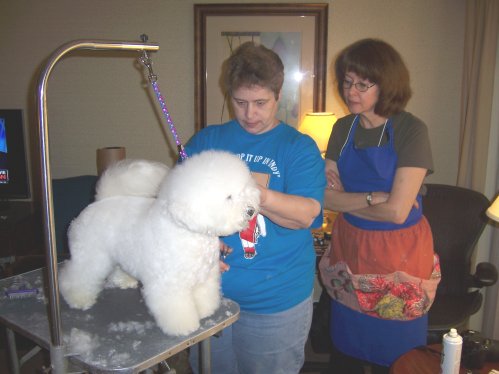
Hard to believe it’s been a full year since the Bichon Frise National Specialty (which I call Bichonicon) but here we are, down in Indianapolis at the same hotel where, at the 2005 Nationals (also in Indianapolis), we picked up the 12-week-old QBit. QBit had no particular desire to be stuck in a crate for four days, so we handed him off (along with packmate Jack) to a cozy kennel in Wauconda until we get back. We’re showing Aero again this year, and Dash is making his first ring appearance at the nationals.
It’s a smaller show than last year for some reason, but there are still well over a hundred white dogs here, all of which (especially after show grooming) look pretty much alike. Carol spent a good part of today washing, drying, brushing, and tipping Dash (trimming loose ends, which are legion) while listening to the critique of seasoned bichon groomers like Lorrie Carlton of Belle Creek Bichons. (Above, with Carol and Dash.) Dash came out of the process looking pretty damned good, and when he hit the ring for 10-12 month Puppy Dog Sweepstakes mid-afternoon, he took fourth place in his category. That sounds so-so, but these are the nationals–and the handlers who placed first through third in the category are among the superstars in the bichon world: Lorrie Carlton, Lisa Bettis, and Paul Flores. For an amateur handler like Carol to take fourth place against competition like that was something of a coup, especially since Dash was a little tired after all the preparations and didn’t hold his head up as proudly as he usually does.
It’s now 7 PM here, and Carol is down in the grooming area brushing the recently bathed Aero, who sat out today’s events but will be competing in the Amateur Owner/Handler category tomorrow morning. Dash is sacked out in his cushy crate and I’m looking forward to a good night’s sleep myself. Dog shows are a lot more aerobic than I would have expected–but then again, so were silk screening and telescope making. More tomorrow.
